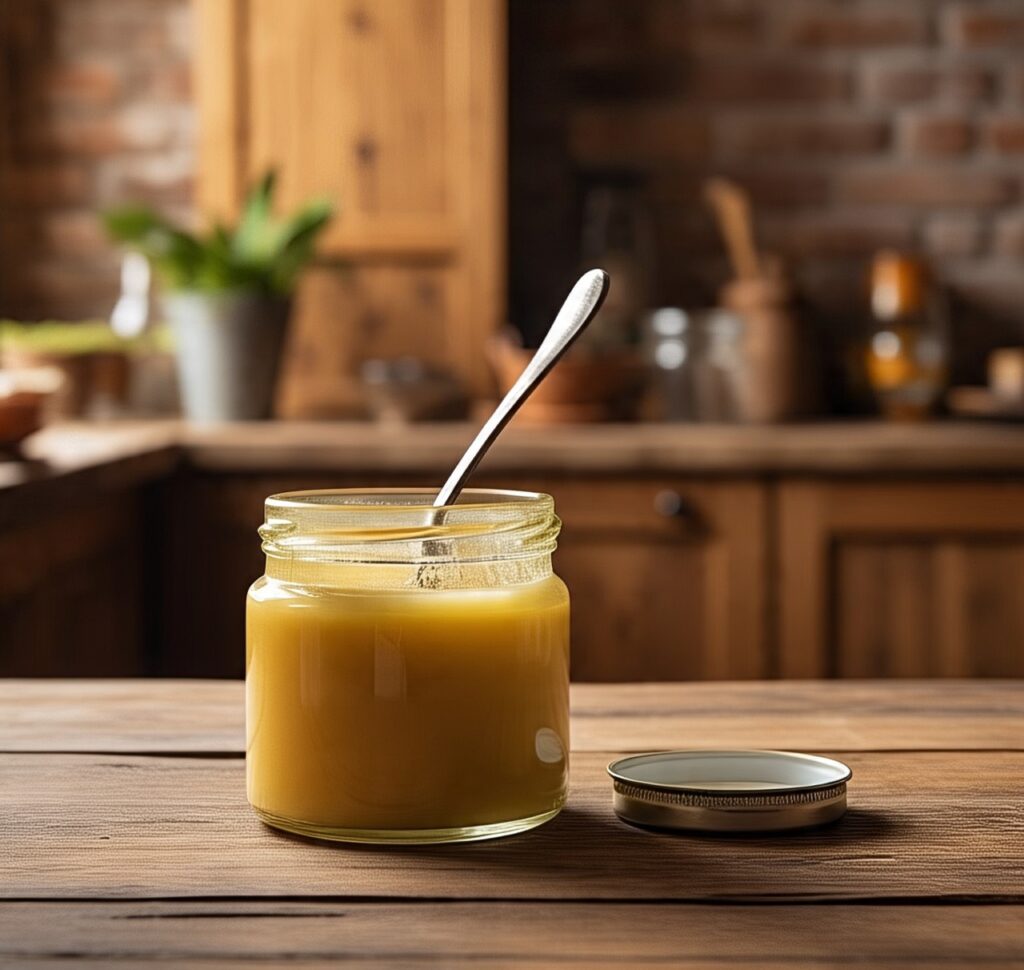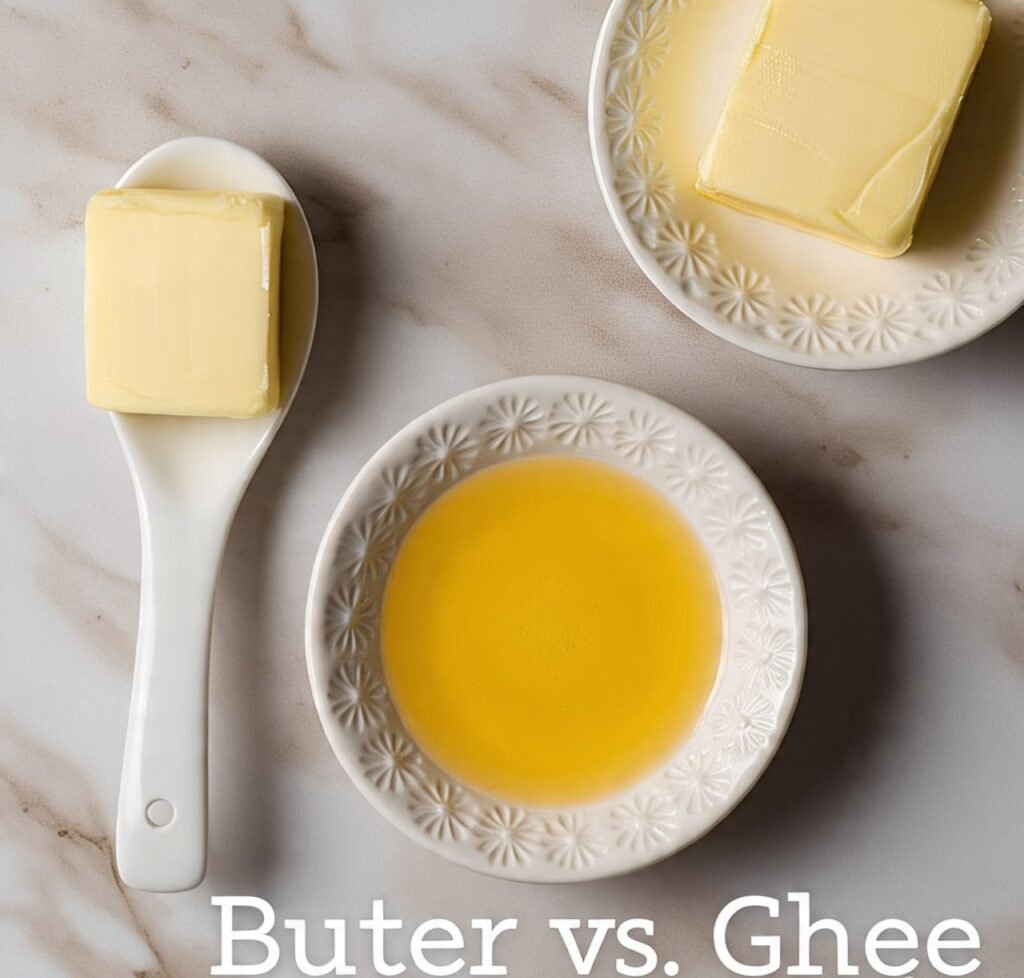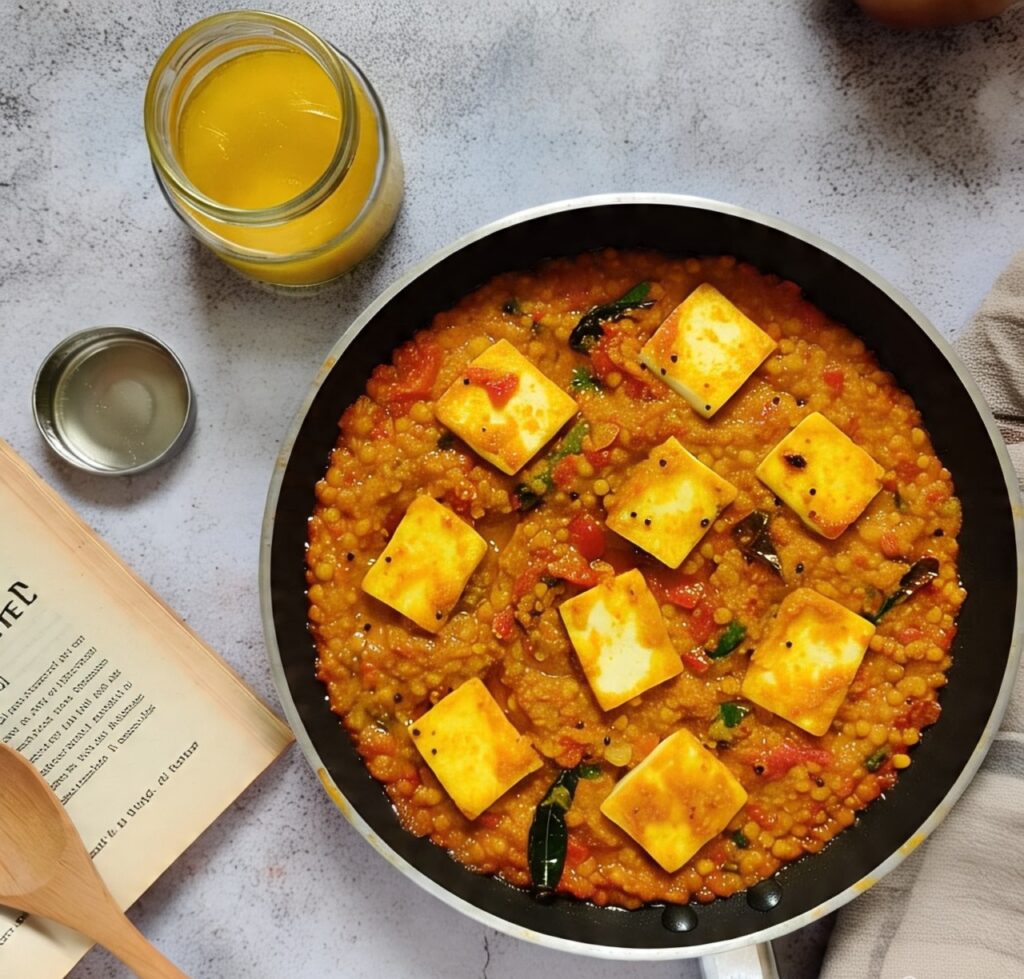
Have you ever eaten something that immediately feels nourishing, almost ancient? That’s ghee. It’s more than just a cooking fat; it’s tradition, health, and flavor wrapped in one golden spoonful. While butter melts quickly into dishes, ghee lingers, enhancing, enriching, and enveloping every bite with depth and warmth.
From ancient Ayurvedic texts to modern gourmet kitchens, ghee has earned its status as a staple—and for good reason. In this blog, we’ll dive deep into what ghee is, how it’s made, its nutritional and culinary value, and why it might just become your new favorite kitchen companion.
What is Ghee?

Ghee is clarified butter—but with character. Technically speaking, it’s butter that has been simmered to remove water and milk solids, leaving behind pure butterfat. But that’s just the beginning.
Unlike regular clarified butter, ghee is cooked longer, allowing the milk solids to caramelize before they’re removed. This gives ghee a distinctive nutty flavor, a rich aroma, and a deep golden hue. It’s the kind of flavor that adds soul to a dish.
In India, ghee isn’t just food—it’s sacred. Used in cooking, religious rituals, and even medicine, it holds a place of honor in homes and hearts.
How Ghee is Made: A Simple, Sacred Process
Making ghee at home is like performing a gentle alchemy. All you need is unsalted butter and a little patience. Here’s a step-by-step guide:
Ingredients:
- 1 lb (450g) unsalted butter (preferably grass-fed)
Method:
- Melt the butter in a heavy-bottomed saucepan over medium-high heat.
- The butter will separate into three layers:
- A white foamy top (milk solids)
- Clear golden liquid (butterfat)
- Sediment at the bottom
- Once it starts to foam, reduce the heat to low and continue simmering.
- Over the next 20–30 minutes, the foam will break apart, and milk solids will brown and sink to the bottom.
- The ghee is ready when:
- It smells nutty and toasty
- The liquid is clear and golden
- No bubbles are forming
- Strain the ghee through a cheesecloth into a glass jar or heatproof container.
- Let it cool and store:
- Room temperature: Up to 3 months
- Refrigerated: Up to 6 months
🛑 Caution: Ghee is extremely hot during straining. Pour slowly and avoid splashing.
Why Ghee Outshines Butter
You might wonder—if ghee is just clarified butter, why not stick with the regular stuff?
Here’s a quick comparison to clarify:
| Feature | Ghee | Butter |
|---|---|---|
| Flavor | Nutty, rich, aromatic | Creamy, slightly tangy |
| Smoke Point | ~450°F (232°C) | ~350°F (177°C) |
| Lactose/Casein | Removed | Present |
| Shelf Stability | Stable at room temp | Requires refrigeration |
| Culinary Uses | Sautéing, frying, finishing sauces | Baking, spreads, sauces |
Because the milk solids are removed, ghee is safe for many with lactose intolerance or casein sensitivity. And with its high smoke point, it’s ideal for high-heat cooking where butter would burn.
A Culinary Powerhouse
There’s a time and place for regular butter. But then there are recipes that call for flavor with a bold twist—and that’s when ghee steps up.
Where Ghee Shines:

- Indian dishes: Think dal tadka, biryani, or parathas finished with a spoonful of warm ghee.
- Sautéing spices: Ghee brings out the best in mustard seeds, cumin, and curry leaves.
- Roasting vegetables: A light coat of ghee turns any veggie into a flavor bomb.
- On rice or toast: A simple drizzle of melted ghee transforms plain dishes.
But ghee has its limits, too. Because of its strong earthy taste, it may not be ideal for baking light pastries or cakes, where the delicate flavor of butter is key.
Ghee in Ayurveda and Wellness
Beyond the kitchen, ghee holds a special place in Ayurvedic medicine, where it’s considered a “sattvic” food—meaning it promotes purity, clarity, and calmness of mind.
Traditional Ayurvedic Benefits:
- Supports digestion: Ghee lubricates the digestive tract and encourages nutrient absorption.
- Anti-inflammatory: Contains butyrate, which may help reduce gut inflammation.
- Boosts immunity: Rich in fat-soluble vitamins A, D, E, and K.
- Mental clarity: Ghee is thought to nourish brain tissue and enhance memory.
🔗 Harvard Health points out that while ghee offers some advantages, moderation is key due to its high saturated fat content.
A Personal Take: Why Ghee Became My Everyday Essential
I grew up thinking ghee was something reserved for Indian festivals or my grandmother’s kitchen. I watched her spoon it lovingly over steaming rice or melt it into warm halwa, all while telling stories of how her mother made ghee from scratch in the village.
It wasn’t until I started cooking seriously as an adult that I understood its power.
The first time I sautéed cumin in ghee for a simple lentil dish, the aroma alone transported me to childhood kitchens. It wasn’t just nostalgia—it was depth. No oil or butter could match it. Now, it’s in everything from roasted carrots to bulletproof coffee (yes, it works).
Buying Ghee: What to Look For
While you can easily make ghee at home, there are many quality store-bought options available. Look for:
- Grass-fed: Higher in omega-3s and CLA (conjugated linoleic acid)
- Organic: Free from antibiotics and hormones
- Transparent sourcing: Brands that list their dairy source and processing method
🔗 This guide by Bon Appétit highlights some of the best ghee brands for home cooks.
Frequently Asked Questions (FAQ)
❓Is ghee vegan?
No. Ghee is made from butter, which is an animal product.
❓Can I use ghee if I’m lactose intolerant?
Yes, most lactose and casein are removed in the process. However, if you’re extremely sensitive, consult a doctor.
❓Is ghee healthier than oil or butter?
It depends. Ghee is more stable at high heat and richer in certain nutrients, but it’s still a saturated fat. Use in moderation.
❓Does ghee taste like butter?
Not exactly. Ghee is deeper, nuttier, and more aromatic than butter—especially if browned properly.
Final Thoughts: Why Ghee Is Worth the Hype
Ghee isn’t just clarified butter—it’s culinary tradition, functional fat, and flavorful gold. Whether you’re exploring Indian cooking, looking for healthier fats, or just want to take your sautéing game up a notch, ghee is an easy win.
Its versatility, shelf stability, and health benefits make it one of the most underrated staples in modern kitchens. Plus, making it yourself is surprisingly meditative.
🔥 Try It Today
Next time you’re cooking, swap in ghee for oil or butter and notice the difference—not just in taste, but in aroma, texture, and satisfaction. Want more food inspiration? Check out our Indian pantry essentials guide or 5 must-try ghee-based recipes.
Have you tried cooking with ghee? Share your experiences below or tag us on Instagram @GoldenGheeLife.
👉 Liked this post? Subscribe to our newsletter for more culinary deep-dives and cultural food stories!



